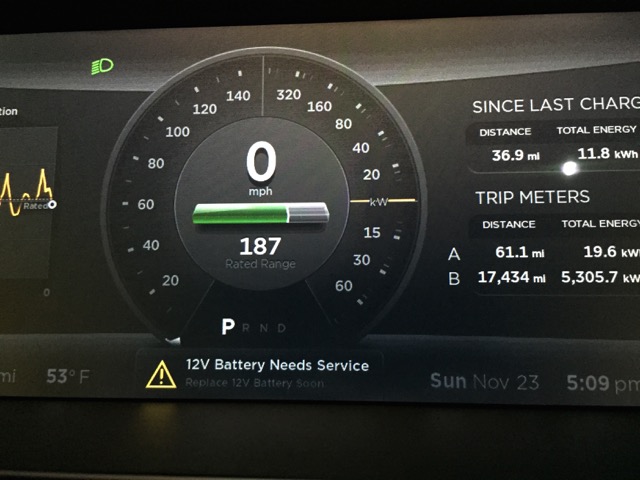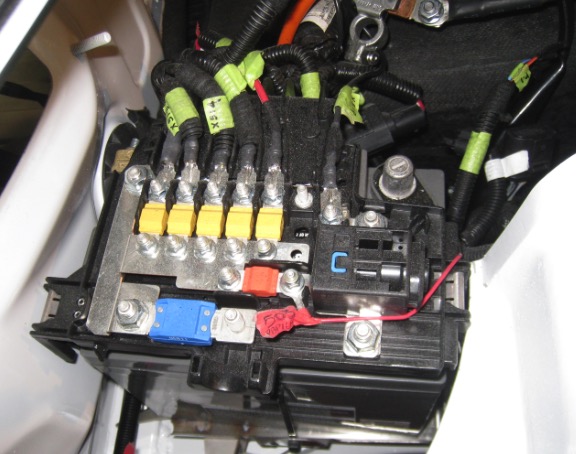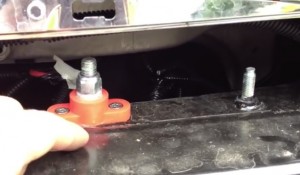Lifestyle
Understanding the Tesla 12V Battery Service Warning

During the time when I was sitting on the sideline waiting patiently for delivery of my Model S, I read up on pretty much anything and everything related to the vehicle. I remember reading about 12V battery failures on the Model S, something Elon himself even commented on during one of the earnings calls.
RELATED: Tesla Model S 12V Lithium-Ion battery replacement (up to 70% lighter, 4x life)
It was reported that Tesla had chosen a poor vendor for the 12V battery which impacted early Model S owners but apparently this issue is still happening across later production vehicles. My Model S as well as several others that I personally know of received the 12V battery service indicator. For me this took place after 7 months and 18,000 miles of ownership.
Purpose of the Tesla 12V battery
The 12V battery in the Model S performs many of the same duties as it would in any internal combustion engine (ICE) car.The connections to the 12V battery on a Model S appear to be a bit more complex than in a traditional ICE as seen in the following picture (source: TMC forum).
RELATED: Why Tesla’s lead acid 12V battery needs to be lithium-ion based
The 12V battery maintains power for critical systems when the main battery pack is damaged or disabled. It powers the hazard lights, airbags, door locking and unlocking operations, as well as other critical componets of the Model S. The 12V battery also ensures that electronics are “awake” and listening to the key FOB in order to automatically lock and unlock the vehicle based on proximity. It also allows the car to maintain its 3G connection for remote access when the rest of the vehicle is powered off. If the 12V battery happens to fail, it will isolate the main battery pack from the car and prevent charging. This is a safety feature of the Model S designed to help protect first responders in the event of an accident.
What does my warning mean?
The “12V Battery Needs Service” warning can indicate a number of problems and the only way to truly understand the reason for the alert is to call Tesla Service (they’re available 24×7) and have them pull the logs. This is something that Tesla service can diagnose remotely.
In severe cases Tesla Service will tell you to stop driving the car, but generally it’s an indication that the voltage level has dropped below a certain threshold but the vehicle can continue to operate normally until replaced. In the rare event that the the 12V battery dies while driving, the car will become disabled and will require a jump start to power on again. Our friend Kman has a good video on getting access to the terminals behind the nosecone to jump start the 12V, but please consult Tesla service and take caution before attempting this on your own.
Depending on the severity of the issue, there may be a 2-3 week lead time before Tesla Service replaces the 12V battery.
Many owners manage to get the battery replaced quickly, but in my case a busy Tesla Service Center combined with the fact that it was Thanksgiving holiday during a snowy New England week, had me driving with the warning light on for almost 2 weeks (about 1,000 miles) without encountering any issues.
Another interesting point to note is that Tesla may call you before you even see 12V battery service warning. Multiple owners have reported this proactive stance in advance of a warning which is great to see. Evidently Tesla’s early warning threshold is supersedes the trigger that kicks off the dash indicator.
Why are the 12V batteries failing?
Some owners are on their 3rd 12V battery already. Many others are reporting failures at the 1 year mark. In ICE cars you can normally expect about 4 years of life before needing to replace the 12V battery which begs the question – why are Tesla 12V batteries failing?
Some of the failures have been in the DC to DC converter that charges the 12V battery through the main battery pack. That converter can be seen as an equivalent to the alternator in your traditional ICE car. However, this doesn’t seem to be the main cause of the 12V battery failures. Current conjecture is that vampire load and the excessive strain on the 12V are causing the reliability issues.
Tesla may have a lingering design issue in their use of the 12V battery.
From my reading, I think they upgraded the quality of the battery in the earlier models but we’re still facing the same underlying design issue in the way the 12V is stressed. Can Tesla fix the way the 12V battery is used with software updates alone? We don’t know, but fortunately they’re taking care of all of the replacements in the meantime. Unless they can address it remotely via software updates, there could be a factory “recall” brewing (and I use this term loosely).
Either way, Tesla should be more upfront about these issues and let owners know what they’re doing to address the underlying problem.
Getting the 12V battery serviced
From everthing I’ve heard and experienced through my own Model S, the replacement including labor and parts is 100% covered by Tesla.
Tesla Service can handle the replacement at your location, but given the poor weather conditions here in New England, I opted to have them pick up my Model S and do the replacement in the comfort of their own Service Center. They were able to service it within the same day, and to Tesla fashion they also updated/fixed a bunch of other minor things for free, while at it.
Summary
The 12V battery is a relatively inexpensive part in the Model S and is fairly simple to replace, but the bigger concern is why they seem to be failing so quickly. It isn’t a major issue for now but certianly something we should continue monitoring as concerned Model S owners.
I’ve started a poll over on TMC to see what kind of failure rate we’re seeing on the 12V battery so feel free to contribute to it or use it as a way monitor progress. So far over 75% of respondents have had their 12V battery replaced within 2 years.

Lifestyle
Tesla Model S Plaid battles China’s 1500 hp monster Nurburgring monster, with surprising results
There is just something about Tesla’s tuning and refinement that makes raw specs seem not as game-changing.

The Tesla Model S Plaid has been around for some time. Today, it is no longer the world’s quickest four-door electric sedan, nor is it the most powerful. As per a recent video from motoring YouTube channel Carwow, however, it seems like the Model S Plaid is still more than a match for some of its newer and more powerful rivals.
The monster from China
The Xiaomi SU7 Ultra is nothing short of a monster. Just like the Model S Plaid, it features three motors. It also has 1,548 hp and 1,770 Nm of torque. It’s All Wheel Drive and weighs a hefty 2,360 kg. The vehicle, which costs just about the equivalent of £55,000, has been recorded setting an insane 7:04.957 at the Nurburgring, surpassing the previous record held by the Porsche Taycan Turbo GT.
For all intents and purposes, the Model S Plaid looked outgunned in Carwow’s test. The Model S Plaid is no slouch with its three motors that produce 1,020 hp and 1,420 Nm of torque. It’s also a bit lighter at 2,190 kg despite its larger size. However, as the Carwow host pointed out, the Model S Plaid holds a 7:25.231 record in the Nurburgring. Compared to the Xiaomi SU7 Ultra’s record, the Model S Plaid’s lap time is notably slower.
Real-world tests
As could be seen in Carwow’s drag races, however, Tesla’s tech wizardry with the Model S Plaid is still hard to beat. The two vehicles competed in nine races, and the older Model S Plaid actually beat its newer, more powerful counterpart from China several times. At one point in the race, the Xiaomi SU7 Ultra hit its power limit due to its battery’s temperature, but the Model S Plaid was still going strong.
The Model S Plaid was first teased five years ago, in September 2020 during Tesla’s Battery Day. Since then, cars like the Lucid Air Sapphire and the Xiaomi SU7 Ultra have been released, surpassing its specs. But just like the Model Y ended up being the better all-rounder compared to the BYD Sealion 7 and the MG IM6, there is just something about Tesla’s tuning and refinement that makes raw specs seem not as game-changing.
Check out Carwow’s Model S Plaid vs Xiaomi SU7 drag race video below.
Lifestyle
500-mile test proves why Tesla Model Y still humiliates rivals in Europe
On paper, the BYD Sealion 7 and MG IM6 promised standout capabilities against the Model Y.

BYD is seeing a lot of momentum in Europe, so much so that mainstream media has taken every opportunity to argue that the Chinese automaker has beaten Tesla in the region. But while BYD sales this year in Europe are rising and Tesla’s registrations remain challenged, the raw capabilities of vehicles like the Model Y are difficult to deny.
This was highlighted in a 500-mile challenge by What Car? magazine, which showed that the new Tesla Model Y is more efficient, cheaper to run, and more reliable than rivals like the BYD Sealion 7, and even the nearly 400 KW-charging MG IM6.
Range and charging promises
On paper, the BYD Sealion 7 and MG IM6 promised standout capabilities against the Model Y. The Sealion 7 had more estimated range and the IM6 promised significantly faster charging. When faced with real-world conditions, however, it was still the Model Y that proved superior.
During the 500-mile test, the BYD nearly failed to reach a charging stop, arriving with less range than its display projected, as noted in a CarUp report. MG fared better, but its charging speeds never reached its promised nearly-400 kW charging speed. Tesla’s Model Y, by comparison, managed energy calculations precisely and arrived at each stop without issue.
Tesla leads in areas that matter
Charging times from 25% to 80% showed that the MG was the fastest at 17 minutes, while Tesla and BYD were close at 28 and 29 minutes, respectively. Overall efficiency and cost told a different story, however. The Model Y consumed 19.4 kWh per 100 km, compared to 22.2 for MG and 23.9 for BYD. Over the full trip, Tesla’s charging costs totaled just £82 thanks to its supercharger network, far below BYD’s £130 and MG’s £119.
What Car? Magazine’s testers concluded that despite BYD’s rapid sales growth and the MG IM6’s seriously impressive charging speeds, Tesla remains the more compelling real-world choice. The Model Y just offers stability, efficiency, and a proven charging infrastructure through its Supercharging network. And as per the magazine’s hosts, the Model Y is even the cheapest car to own among the three that were tested.
Watch What Car? Magazine’s 500-mile test in the video below.
Lifestyle
Tesla Cybertruck slapped with world’s least intimidating ticket, and it’s pure cringe
One cannot help but cringe and feel second-hand embarrassment at the idea of a person just driving around with a stack of these babies.

A Cybertruck parked at Stanford Shopping Center in California was recently hit with what might be the most try-hard piece of paper ever slipped under a wiper blade: a “fake citation” accusing the driver of supporting a “fascist car.”
The note, shared on X by Tesla staff program manager Ryan Torres, quickly made the rounds on X, where it quickly gained attention as an example of how not to protest.
The world’s least intimidating ticket
According to the citation, the supposed “violation” was “driving a fascist car.” The remedial action? Take the bus, call an Uber, or ride a bike. The note also dubbed Elon Musk a “chainsaw-wielding Nazi billionaire.” Now, protests against Tesla and Elon Musk have become commonplace this year, but one cannot help but cringe and feel second-hand embarrassment at the idea of a person just driving around with a stack of fake anti-Tesla/Musk citations.
Torres pointed out the irony himself in his post on X. Tesla currently employs over 140,000 Americans, and SpaceX has put the U.S. firmly back at the top of space technology. As Torres put it, maybe the person behind the world’s least intimidating ticket should “read a book on innovation before vandalizing” other people’s property.
Peak performative clownery
Not to mention that the fake ticket’s logic collapses under its own weight. EVs like the Cybertruck are literally designed to reduce emissions, not “destroy the economy.” If anything, Tesla has bolstered the United States’ economy by fueling jobs in engineering, manufacturing, and clean energy. It’s not the first time a Tesla has been the target of vandalism or politically charged notes, but this one stands out for sheer cringe value.
Torres summed it up neatly: “Peak clownery.” On that point, at least, the citation earns full marks. In a way, though, perhaps cringe fake tickets are not as bad as the literal firebombs that were being thrown at Tesla stores and cars earlier this year because some critics were gleefully misinformed about Elon Musk.











